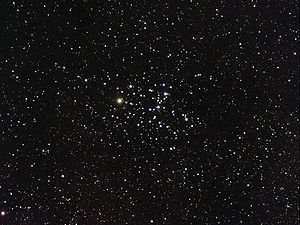- Butterfly Cluster
-
Butterfly Cluster 
Observation data (J2000.0 epoch) Constellation Scorpius Right ascension 17h 40.1m Declination −32° 13′ Distance 1.6 kly (491 Pc) Apparent magnitude (V) 4.2 Apparent dimensions (V) 25′ Physical characteristics Radius 6 light years Other designations Messier 6, NGC 6405, Collinder 341, Melotte 178, Lund 769, OCL 1030, ESO 455-SC030 See also: Open cluster, List of open clusters The Butterfly Cluster (cataloged as Messier 6 or M6, and as NGC 6405) is an open cluster of stars in the constellation of Scorpius. Its name derives from the vague resemblance of its shape to a butterfly.
The first astronomer to record the Butterfly Cluster's existence was Giovanni Battista Hodierna in 1654. However, Robert Burnham, Jr has proposed that the 1st century astronomer Ptolemy may have seen it with the naked eye while observing its neighbor the Ptolemy Cluster (M7). Charles Messier catalogued the cluster as M6 in 1764. It was not till the 20th century that star counts, distance, and other properties were measured.
Characteristics
Most of the bright stars in this cluster are hot, blue B type stars but the brightest member is a K type orange giant star, BM Scorpii, which contrasts sharply with its blue neighbours in photographs. BM Scorpii, is classed as a semiregular variable star, its brightness varying from magnitude +5.5 to magnitude +7.0.
Estimates of the Butterfly Cluster's distance have varied over the years, with a mean value of around 1,600 light years, giving it a spatial dimension of some 12 light years. Modern measurements show its total visual brightness to be magnitude 4.2.
See also
- Messier Object
- List of Messier objects
- List of open clusters
- New General Catalogue
External links
 Media related to Messier 6 at Wikimedia Commons
Media related to Messier 6 at Wikimedia Commons- Messier 6, SEDS Messier pages
- The Butterfly Cluster on WikiSky: DSS2, SDSS, GALEX, IRAS, Hydrogen α, X-Ray, Astrophoto, Sky Map, Articles and images
Messier objects List M1 · M2 · M3 · M4 · M5 · M6 · M7 · M8 · M9 · M10 · M11 · M12 · M13 · M14 · M15 · M16 · M17 · M18 · M19 · M20 · M21 · M22 · M23 · M24 · M25 · M26 · M27 · M28 · M29 · M30 · M31 · M32 · M33 · M34 · M35 · M36 · M37 · M38 · M39 · M40 · M41 · M42 · M43 · M44 · M45 · M46 · M47 · M48 · M49 · M50 · M51 · M52 · M53 · M54 · M55 · M56 · M57 · M58 · M59 · M60 · M61 · M62 · M63 · M64 · M65 · M66 · M67 · M68 · M69 · M70 · M71 · M72 · M73 · M74 · M75 · M76 · M77 · M78 · M79 · M80 · M81 · M82 · M83 · M84 · M85 · M86 · M87 · M88 · M89 · M90 · M91 · M92 · M93 · M94 · M95 · M96 · M97 · M98 · M99 · M100 · M101 · M102 · M103 · M104 · M105 · M106 · M107 · M108 · M109 · M110See also Categories:- Messier objects
- NGC objects
- Open clusters
- Scorpius constellation
- Orion arm
Wikimedia Foundation. 2010.
